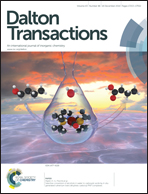Steric and electronic effects on arylthiolate coordination in the pseudotetrahedral complexes [(TpPh,Me)Ni–SAr] (TpPh,Me = hydrotris{3-phenyl-5-methyl-1-pyrazolyl}borate)†
Abstract
Synthesis and characterization of several new pseudotetrahedral arylthiolate complexes [(TpPh,Me)Ni–SAr] (TpPh,Me = hydrotris{3-phenyl-5-methyl-1-pyrazolyl}borate; Ar = Ph, 2,4,6-iPr3C6H2, C6H4-4-Cl, C6H4-4-Me, C6H4-4-OMe) are reported, including X-ray crystal structures of the first two complexes. With prior results, two series of complexes are spanned, [(TpPh,Me)Ni–S–2,4,6-R′′3C6H2] (R′′ = H, Me, iPr) plus the xylyl analogue [(TpPh,Me)Ni–S–2,6-Me2C6H3], as well as [(TpPh,Me)Ni–S–C6H4–4-Y] (Y = Cl, H, Me, OMe), intended to elucidate steric and/or electronic effects on arylthiolate coordination. In contrast to [(TpMe,Me)Ni–SAr] analogues that adopt a sawhorse conformation, the ortho-disubstituted complexes show enhanced trigonal and Ni–S–Ar bending, reflecting the size of the 3-pyrazole substituents. Moreover, weakened scorpionate ligation is implied by spectroscopic data. Little spectroscopic effect is observed in the series of para-substituted complexes, suggesting the observed effects are primarily steric in origin. The relatively electron-rich and encumbered complex [(TpPh,Me)Ni–S–2,4,6-iPr3C6H2] behaves uniquely when dissolved in CH3CN, forming a square planar solvent adduct with a bidentate scorpionate ligand, [(κ2-TpPh,Me)Ni(NCMe)(S–2,4,6-iPr3C6H2)]. This adduct was isolated and characterized by X-ray crystallography. Single-point DFT and TD-DFT calculations on a simplified [(κ2-Tp)Ni(NCMe)(SPh)] model were used to clarify the electronic spectrum of the adduct, and to elucidate differences between Ni–SAr bonding and spectroscopy between pseudotetrahedral and square planar geometries.
![Graphical abstract: Steric and electronic effects on arylthiolate coordination in the pseudotetrahedral complexes [(TpPh,Me)Ni–SAr] (TpPh,Me = hydrotris{3-phenyl-5-methyl-1-pyrazolyl}borate)](/en/Image/Get?imageInfo.ImageType=GA&imageInfo.ImageIdentifier.ManuscriptID=C4DT02726D&imageInfo.ImageIdentifier.Year=2014)

 Please wait while we load your content...
Please wait while we load your content...